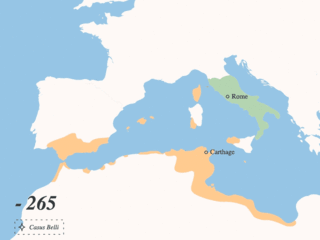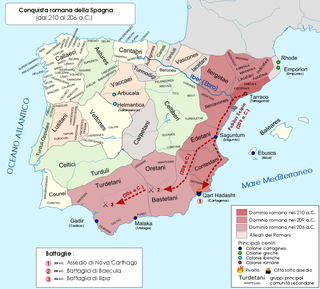
Hannibal was a Carthaginian general and statesman who commanded the forces of Carthage in their battle against the Roman Republic during the Second Punic War.

The Punic Wars were a series of wars between 264 and 146 BC fought between Rome and Carthage. Three conflicts between these states took place on both land and sea across the western Mediterranean region and involved a total of forty-three years of warfare. The Punic Wars are also considered to include the four-year-long revolt against Carthage which started in 241 BC. Each war involved immense materiel and human losses on both sides.

The Second Punic War was the second of three wars fought between Carthage and Rome, the two main powers of the western Mediterranean in the 3rd century BC. For 17 years the two states struggled for supremacy, primarily in Italy and Iberia, but also on the islands of Sicily and Sardinia and, towards the end of the war, in North Africa. After immense materiel and human losses on both sides the Carthaginians were defeated. Macedonia, Syracuse and several Numidian kingdoms were drawn into the fighting, and Iberian and Gallic forces fought on both sides. There were three main military theatres during the war: Italy, where Hannibal defeated the Roman legions repeatedly, with occasional subsidiary campaigns in Sicily, Sardinia and Greece; Iberia, where Hasdrubal, a younger brother of Hannibal, defended the Carthaginian colonial cities with mixed success before moving into Italy; and Africa, where Rome finally won the war.

Mago Barca was a Barcid Carthaginian who played an important role in the Second Punic War, leading forces of Carthage against the Roman Republic in Iberia and northern and central Italy. Mago was the third son of Hamilcar Barca, was the brother of Hannibal and Hasdrubal, and was the brother-in-law of Hasdrubal the Fair.

The Battle of Lake Trasimene was fought when a Carthaginian force under Hannibal ambushed a Roman army commanded by Gaius Flaminius on 21 June 217 BC, during the Second Punic War. The battle took place on the north shore of Lake Trasimene, to the south of Cortona, and resulted in a heavy defeat for the Romans.

Titus Quinctius Flamininus was a Roman politician and general instrumental in the Roman conquest of Greece.

Hasdrubal Barca, a latinization of ʿAzrubaʿal son of Hamilcar Barca, was a Carthaginian general in the Second Punic War. He was the brother of Hannibal and Mago Barca.

The Battle of Baecula was a major field battle in Iberia during the Second Punic War. Roman Republican and Iberian auxiliary forces under the command of Scipio Africanus routed the Carthaginian army of Hasdrubal Barca.

Gaius Claudius Nero was a Roman general active during the Second Punic War against the invading Carthaginian force, led by Hannibal Barca. During a military career that began as legate in 214 BC, he was praetor in 212 BC, propraetor in 211 BC during the siege of Capua, before being sent to Spain that same year. He became consul in 207 BC.
The Battle of the Upper Baetis was a double battle, comprising the battles of Castulo and Ilorca, fought in 211 BC during the Second Punic War between a Carthaginian force led by Hasdrubal Barca and a Roman force led by Publius Cornelius Scipio and his brother Gnaeus. The immediate result was a Carthaginian victory in which both Roman brothers were killed. Before this defeat, the brothers had spent seven years campaigning against the Carthaginians in Hispania, thus limiting the resources available to Hannibal, who was simultaneously fighting the Romans in Italy.

The first Battle of Herdonia was fought in 212 BC during the Second Punic War between Hannibal's Carthaginian army and Roman forces led by Praetor Gnaeus Fulvius Flaccus, brother of the consul. The Roman army was destroyed, leaving Apulia free of Romans for the year.

The First Battle of Capua was fought in 212 BC between Hannibal and two Roman consular armies. The Roman force was led by two consuls, Quintus Fulvius Flaccus and Appius Claudius Pulcher. The Roman force was defeated, but managed to escape. Hannibal temporarily managed to raise the siege of Capua. A tactical Carthaginian victory, it ultimately did not help the Capuans.

The Battle of the Silarus was fought in 212 BC between Hannibal's army and a Roman force led by centurion Marcus Centenius Penula. The Carthaginians were victorious, destroying the entire Roman army and killing 15,000 Roman soldiers in the process.

The Battle of Numistro was fought in 210 BC between Hannibal's army and one of the Roman consular armies led by consul Marcus Claudius Marcellus. It was the fourth time they met in a battle. Previous encounters were located around the walls of Nola (Campania) in 216, 215, and 214 and had been favourable for the Roman side.
Tiberius Sempronius Longus was a Roman consul during the Second Punic War and a contemporary of Publius Cornelius Scipio. In 217 BC, Sempronius and the elder Scipio were elected as consuls for 218 BC. At the outbreak of the war in 218 BC, he was ordered to conduct the war effort in Sicily and Africa, while Scipio was sent to the Iberian Peninsula to attack Hannibal himself. Sempronius was allocated two Roman legions, 16,000 allied infantry, 1,800 allied cavalry, 160 quinqueremes and 20 lighter vessels. As soon as his army was assembled he moved his forces to Sicily. Striking from Lilybaeum Sempronius captured Malta from the Carthaginians.

The Battle of Tarentum in March 212 BC was a military engagement in the Second Punic War.

The Battle of Canusium also known as the Battle of Asculum was a three-day engagement between the forces of Rome and Carthage. It took place in Apulia during the spring of 209 BC, the tenth year of the Second Punic War. A larger Roman offensive, of which it was a part, aimed to subjugate and to punish cities and tribes that had abandoned the alliance with Rome after the Battle of Cannae, and to narrow the base of the Carthaginian leader, Hannibal, in southern Italy.
This section of the timeline of Hispania concerns Spanish and Portuguese history events from the Carthaginian conquests to before the barbarian invasions.
Lucius Veturius Philo was a curule aedile in 210 BC, praetor of Cisalpine Gaul in 209 BC, propraetor of the same province in 208 BC, consular legate in 207 BC, consul in 206 BC, and magister equitum in 205 BC. He was renowned for having been the first to announce to the Roman Senate the news of the great victory won over Hannibal Barca at the Battle of Zama, which ended the Second Punic War.













